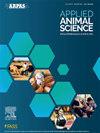Effects of maternal bovine appeasing substance, metaphylaxis with tulathromycin, or a combination of both in high-risk, newly received feedlot heifers
IF 1.5
Q3 AGRICULTURE, DAIRY & ANIMAL SCIENCE
引用次数: 0
Abstract
Objective
Our objective was to evaluate effects of maternal bovine appeasing substance and metaphylaxis using tulathromycin on health and performance of feedlot heifers during a 63-d receiving period.
Materials and Methods
High-risk beef heifers (n = 552; initial BW = 187 ± 7 kg) were stratified by initial BW and pre-existing ranch tag and randomly assigned to 1 of 4 treatments arranged in a 2 × 2 factorial: (1) maternal bovine appeasing substance administration on d 0 and 14 (FERA), (2) metaphylaxis with tulathromycin on d 0 (META), (3) FERA and META administration (FERAMETA), and (4) no FERA or META (CON). A generalized complete block design was used, where heifers were blocked by truckload (n = 5), with each block consisting of 2 pens per treatment. Tulathromycin was administered subcutaneously in the neck at 2.5 mg/kg of BW. A total of 5.0 mL of maternal bovine appeasing substance was administered topically directly behind the poll, and 5.0 mL was administered directly above the muzzle.
Results and Discussion
Heifers administered FERA tended to have reduced morbidity from bovine respiratory disease, and the main effect of META reduced percentage of initial, secondary, and tertiary treatment for bovine respiratory disease. Total antimicrobial cost and units administered were less for META. Heifers that received META had greater ADG from d 0 to 14 and overall (d 0 to 63). An interaction existed for G:F from d 0 to 63 such that FERA was the greatest, META and FERAMETA were intermediate, and CON was least.
Implications and Applications
Health and performance of high-risk feedlot heifers was improved by META, and the combination of FERA and META may have additive benefit.
母牛安抚物质,过敏反应与土拉霉素,或两者的组合在高风险,新接受饲养场小牛的影响
目的评价母牛安抚物质和图拉霉素过敏反应在63 d内对饲养场小母牛健康和生产性能的影响。材料与方法根据初始体重和已有牧场标签对552头高危肉牛进行分层,随机分为4组,按2 × 2因子进行处理:(1)第0天和第14天给母牛安抚物质(FERA),(2)第0天和第14天给土拉霉素过敏反应(META),(3)给FERA和META (FERAMETA),(4)不给FERA或META (CON)。采用了一种广义的完整块设计,其中小母牛被卡车装载(n = 5)阻挡,每个块由2个猪圈组成,每次处理。图拉霉素按2.5 mg/kg体重皮下注射于颈部。母牛安抚物质共5.0 mL直接在轮轮后面局部施用,5.0 mL直接在口鼻上方施用。结果与讨论经FERA处理的小母牛容易降低牛呼吸道疾病的发病率,META的主要作用是降低牛呼吸道疾病的初始、二次和三级治疗的百分比。META组抗菌药物总费用和使用单位较低。在第0 ~ 14天和第0 ~ 63天,接受META治疗的小母牛平均日增重更高。G:F在d 0 ~ d 63之间存在交互作用,其中FERA最大,META和FERAMETA居中,CON最小。META可改善高风险饲养场小母牛的健康和生产性能,与META联合使用可能具有附加效益。
本文章由计算机程序翻译,如有差异,请以英文原文为准。
求助全文
约1分钟内获得全文
求助全文

 求助内容:
求助内容: 应助结果提醒方式:
应助结果提醒方式:


